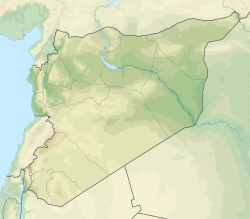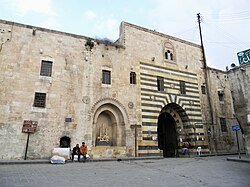Ancient Aleppo
UNESCO World Heritage Site | |
|---|---|
 Ancient Aleppo | |
| Location | Aleppo, Syria |
| Includes | Citadel of Aleppo, Al-Madina Souq |
| Criteria | Cultural: (iii), (iv) |
| Reference | 21 |
| Inscription | 1986 (10th Session) |
| Endangered | 2013–2020 |
| Area | 364 ha (1.41 sq mi) |
| Coordinates | 36°12′09″N 37°09′46″E / 36.20250°N 37.16278°E |
The Ancient City of Aleppo (
Characterized by its large mansions, narrow alleys, covered
An estimated 30% of the Ancient City of Aleppo was
and other structures dating back to medieval times.Origins and founding
Lying on the left bank of
The newer Jdeydeh quarters of the old city were first built by the Christians during the early 15th century in the northern suburbs of the ancient city, after the Mongol withdrawal from Aleppo. Jdeydeh is one of the finest examples of a cell-like quarter in Aleppo. As a result of the economic development, many other quarters were established outside the walls of the ancient city during the 15th and 16th centuries.
-
Aleppo in 1912
-
Pattern of ancient Aleppo
-
Khusruwiyah Mosque, Khan al-Shouneh and Carlton Citadel Hotel were all destroyed during the battle of Aleppo
Historical timeline
Throughout its history, Aleppo has been part of the following states:
- c. 2400 BC – mid 23rd century BC, Kingdom of Armi
- mid 23rd century BC – mid 22nd century BC, Akkadian Empire
- 21st century BC – 19th century BC, Eblaite Kingdom
- c. 1800 BC – 1595 BC, Amorite Kingdom of Yamhad
- 1595 BC – c. 1500 BC, Hittite Kingdom
- c. 1500 BC – c. 1450 BC, Mitanni
- c. 1450 BC – c. 1350 BC, New Kingdom of Egypt
- c. 1350 BC – early 12th century BC, Hittite Kingdom
- 11th century BC, Syro-Hittite kingdom of Palistin
- 10th century BC, Syro-Hittite kingdom of Bit Agusi
- 9th century BC – late 7th century BC, Neo-Assyrian Empire
- early 6th century BC – mid-6th century BC, Chaldean Empire
- c. 550 BC – c. 350 BC, Persian Achaemenid Empire
- 333–312 BC, Macedonian Empire
- 312–88 BC, Seleucid Empire
- 88–64 BC, Armenian Empire
- 64–27 BC, Roman Republic
- 27 BC – 395 AD, Roman Empire
- 476–608, Byzantine Empire
- 608–622, Sassanid Persia
- 622–637, Byzantine Empire (restored)
- 637–661, Rashidun Caliphate
- 661–750, Umayyad Caliphate
- 750–878, Abbasid Caliphate
- 878–905, Tulunids
- 905–941, Abbasid Caliphate (restored)
- 941–944, Ikhshidids
- 944–1003, Hamdanids
- 1003–1038, Fatimid Caliphate
- 1038–1080, Mirdasids
- 1080–1086, Uqaylids
- 1086–1118, Seljuq Empire
- 1118–1128, Artuqids
- 1128–1183, Zengids
- 1183–1260, Ayyubids
- 1260 March–October, Mongol Empire
- 1260–1400, Mamluk Sultanate
- 1400 Timurid Empire
- 1400–1516, Mamluk Sultanate(restored)
- 1516–1918, Ottoman Empire
- 1920 March–July, Arab Kingdom of Syria
- 1920–1924, State of Aleppo under the French Mandate
- 1924–1946, French Mandate of Syria
- 1946–1958, Syrian Republic
- 1958–1961, United Arab Republic
- 1961–2024, Ba'athist Syria
- 2024–present, Syria
Pre-history and pre-classical era

Aleppo has scarcely been touched by archaeologists, since the modern city occupies its ancient site.
Early Bronze Age
Aleppo appears in historical records as an important city much earlier than Damascus. The first record of Aleppo may be from the third millennium BC if the identification of Aleppo as Armi, a city-state closely related to Ebla is correct. Armi has also been identified with the modern Tell Bazi.[5] Giovanni Pettinato describes Armi as Ebla's alter ego. Naram-Sin of Akkad (or his grandfather Sargon) destroyed both Ebla and Arman in the 23rd century BC.[6][7]
Middle Bronze Age
In the
Yamḥad was destroyed by the
Late Bronze Age
Taking advantage of the power vacuum in the region,
The Hittite
Iron Age
When the Hittite kingdom collapsed in the 12th century BC, Aleppo became part of the
Classical antiquity
Northern Syria was the centre of gravity of the Hellenistic colonizing activity, and therefore of Hellenistic culture in the Seleucid Empire. As did other Hellenized cities of the Seleucid kingdom, Beroea probably enjoyed a measure of local autonomy, with a local civic assembly or boulē composed of free Hellenes.[11]
Beroea remained under Seleucid rule for nearly 300 years until the last holdings of the Seleucid dynasty were handed over to
Beroea is mentioned in 2 Maccabees 13:3.
Medieval period and the expansion of the city

The
On 9 August 1138,
After Tamerlane invaded Aleppo in 1400 and destroyed it, the Christians migrated out of the city walls and established their cell in 1420, at the northwestern suburbs of the city, thus founding the quarters of Jdeydeh. The inhabitants of Jdeydeh were mainly brokers who facilitated trade between foreign traders and local merchants. Many other districts were built outside the historic walls during the 15th and 16th centuries.
Mention is made of the city, by one of the witches, in William Shakespeare's Macbeth, written between 1603 and 1607.[14]
Main sights
Aleppo is characterized by mixed architectural styles, having been ruled, among the other, by Romans, Byzantines, Seljuqs, Mamluks and Ottomans.[15]
Various types of 13th and 14th centuries constructions, such as caravanserais, caeserias, Quranic schools, hammams and religious buildings are found in the
Souqs and Khans

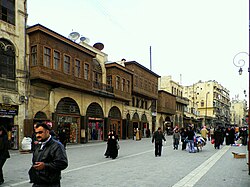
The city's strategic trading position attracted settlers of all races and beliefs who wished to take advantage of the commercial roads that met in Aleppo from as far as China and
Al-Madina Souq, as it is locally known, is an active trade centre for imported luxury goods, such as raw silk from Iran, spices and dyes from India, and coffee from Damascus. Souq al-Madina is also home to local products such as wool, agricultural products and soap. Most of the souqs date back to the 14th century and are named after various professions and crafts, hence the wool souq, the copper souq, and so on. Aside from trading, the souq accommodated the traders and their goods in khans (caravanserais) and scattered in the souq. Other types of small market-places were called caeserias (قيساريات). Caeserias are smaller than khans in their sizes and functioned as workshops for craftsmen. Most of the khans took their names after their location in the souq and function, and are characterized with their beautiful façades and entrances with fortified wooden doors.
The most significant khans within and along the covered area of Souq al-Madina are: Khan al-Qadi from 1450, Khan al-Saboun from the early 16th century, Khan al-Nahhaseen from 1539, Khan al-Shouneh from 1546, Khan al-Jumrok from 1574, Souq Khan al-Wazir from 1682, Souq al-Farrayin, Souq al-Dira', Souq al-Hiraj, Souq al-Attarine, Souq az-Zirb, Souq Marcopoli, Souq as-Siyyagh, The Venetians' Khan,*Souq Khan al-Harir from the second half of the 16th century, Suweiqa, etc.
Other traditional souqs and khans in Jdeydeh quarter (outside the walled city):
- Souq al-Hokedun or "Khan al-Quds". Hokedun means "the spiritual house" in Armenian, as it was built to serve as a settlement for the Armenian pilgrims on their way to Jerusalem. The old part of the Hokedun dates back to the late 15th and early 16th centuries while the newer part was built during the 17th century. Nowadays, it is turned into a big souq with a large number of stores specialized in garment trade.
- Souq as-Souf or the wool market, located at Salibeh street, surrounded with the old churches of the quarter.
- Bawabet al-Qasab, a trade centre for wooden products.[17]
Historic buildings
The most significant historic buildings of the ancient city include:
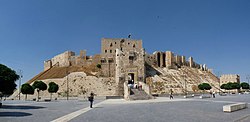





- The Great Mosque of Aleppo (Arabic: جَـامِـع حَـلَـب الْـكَـبِـيْـر, Jāmi‘ Ḥalab al-Kabīr) is the largest and one of the oldest mosques in the city of Aleppo, Syria. It is located in al-Jalloum district of the Ancient City of Aleppo, a World Heritage Site, near the entrance to Al-Madina Souq. The mosque is purportedly home to the remains of Zechariah, the father of John the Baptist, both of whom are revered in Islam[5][6] and Christianity.[7] It was built in the beginning of the 8th century CE. However, the current building dates back to the 11th through 14th centuries. The minaret in the mosque was built in 1090,[8] and was destroyed during fighting in the Syrian Civil War in April 2013.[9]
- The Citadel, a large fortress built atop a huge, partially artificial mound rising 50 m (164 ft) above the city, dates back to the first millennium BC. Recent excavations unearthed a temple and 25 statues dating back to the first millennium BC.[18] Many of the current structures date from the 13th century. The Citadel was extensively damaged by earthquakes, notably during the 1822 Aleppo earthquake.[19]
- Al-Matbakh al-Ajami, an early 12th-century palace located near the citadel, built by the Zengid emir Majd ad-Din bin ad-Daya. The building was renovated during the 15th century. It was the home of the Popular Traditions Museum between 1967–1975.
- Al-Shibani Church-School of the 12th century, an old church and school of the Franciscan Missionaries of Mary located in the old city, currently used as a cultural centre.
- sufi monastery built in 1237 by Dayfa Khatun.
- Bimaristan Arghun al-Kamili, an asylum functioned from 1354 until the early 20th century.
- Dar Rajab Pasha, a large mansion built during the 16th century near al-Khandaq street. During the first decade of the 21st century, the house was renovated and turned into an important cultural centre with a nearby large theatre hall.
- Junblatt Palace, built during the 2nd half of the 16th century by the emir of Kurds in Aleppo and the founder of the Janpolad (Jumblatt) family; Janpolad bek ibn Qasim.
- Beit Marrash, an old Aleppine mansion located in al-Farafira quarter, built at the end of the 18th century by the Marrash family.
- Bab al-Faraj Clock Tower, built in 1898–1899 by the Austrian architect Chartier.[20]
- Grand Serail d'Alep, the former seat of the governor of Aleppo, built during the 1920s and opened in 1933.
- National Library of Aleppo, built during the 1930s and opened in 1945.[21]
The most significant historic buildings of Jdeydeh Christian quarter include:[22]
- Beit Wakil, an Aleppine mansion built in 1603, with unique wooden decorations. One of its decorations was taken to Berlin and exhibited in Pergamon Museum, known as the Aleppo Room.
- Beit Ghazaleh, an old 17th-century mansion characterized with fine decorations, carved by the Armenian sculptor Khachadur Bali in 1691. It was used as an Armenian elementary school during the 20th century.
- Dar Zamaria, built at the end of the 17th century and owned by Zamaria family since the early 18th century. Nowadays, the house is turned into a boutique hotel.
- Beit Achiqbash, an old Aleppine house built in 1757. The building is home to the Popular Traditions Museum since 1975, showing fine decorations of the Aleppine art.
- Dar Basile, an early 18th-century Aleppine house, operating as a private school since 2001.
- Beit Dallal or Dallal House, built in 1826 on the place of an old church and a monastery, nowadays operating as a boutique hotel.
Madrasas

- madrasah; an Islamic-religious school.[23]Nowadays, the 6th century Byzantine columns of the old cathedral can be seen in the hall.
- madrasah in 1168 by Izz Eddin Abdal Malek al-Muqadam during Nur al-Din's reign. It is the oldest operating madrasah in Aleppo.[24]
- Zengid ruler Nur al-Din.[25]
- Az-Zahir Ghazi.[26]
- Ayyubid ruler An-Nasir Yusuf. It is known for its large iwan (courtyard) with a pool in the middle surrounded by arches and ancient columns, sporting capitals with a honeycomb pattern. The same style characterizes the domes of the prayer hall. The mihrab is made of veined white marble, red porphyry and green diorite.[29]
- Ayyubid Sultan al-Malik al-Kamil.[30]
- Al-Sharafiyah Madrasa, located to the northeast of the Great Mosque, founded by Abd al-Rahim ibn al-'Ajami and his son Sharaf al-Din 'Abdul Rahman in 1242.[31]
- Al-Turantaiyah Madrasa, located outside the city walls to the east of Bab al-Nairab, built between 1241–51 by the Aleppine historian Ibn al-Udaym.[32]
- Tekyes structures.[33]
- Al-Uthmaniyah Madrasa, located near Bab al-Nasr, founded by the Ottoman pasha Al-Duraki in 1730, and was originally named Madrasa Ridaiya.[34]
Places of worship
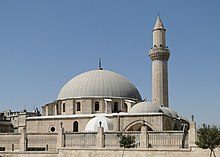
- decumanus. The building was entirely renovated in 1146 and 1401. It is known for its 12th century kuficinscriptions and decorations.
- . It has four façades with different styles.
- Al-Qaiqan Mosque ("Mosque of the Crows") of the 12th century, decorated with two ancient columns in basalt at the entrance. On the walls of the mosque, a stone block with an Anatolian hieroglyphs inscription could be seen.
- Altun Bogha Mosque of the Mamluk era, built in 1318.
- Al-Sahibiyah Mosque of 1350, built adjacent to Khan al-Wazir.
- Al-Tawashi Mosque built in 1398 and restored in 1537. It has a great façade decorated with colonnettes.
- Al-Otrush Mosque, built in 1398 in Mamluk style. It is famous for its decorated façade and the entrance which is topped with traditional Islamic muqarnas. It was restored in 1922.
- Al-Saffahiyah Mosque, erected in 1425 and partly renovated in 1925. It is famous for its preciously decorated octagonal minaret.
- Khusruwiyah Mosque completed in 1547, designed by the famous Ottoman architect Mimar Sinan.
- Al-Adiliyah Mosque, built in 1557[35] by the Ottoman governor of Aleppo Muhammed Pasha. It has a prayer hall preceded by an arcade, with a dome, a mihrab with local faience tiles.
- The old church of the Holy Mother of God of the Armenian Apostolic Church at Jdeydeh quarter, built before 1429.
- The Forty Martyrs Armenian Apostolic cathedral of 1429, located in Jdeydeh quarter.
- Mar Assia al-Hakim Church Syrian Catholic church of the 15th century in Jdeydeh.
- The Dormition of Our Lady Greek Orthodox church of the 15th century in Jdeydeh.
- Churches of Jdeydeh Christian quarter such as the Maronite Saint Elias Cathedral, the Armenian Catholic Cathedral of Our Mother of Reliefs and the Melkite Greek Catholic Cathedral of Virgin Mary.
- The Central Synagogue of Aleppo or al-Bandara synagogue, completed as early as the 9th century by the efforts of the Jewish community. The synagogue was ruined several times until 1428 when it was restored. The Jewish quarter collapsed during the 1822 Aleppo earthquake.[19] Recently, the building was renovated by the efforts of Aleppine Jewish migrants in United States.
Gates

The old part of the city is surrounded with 5-kilometre-long (3.1-mile) thick walls, pierced by the nine historical gates (many of them are well-preserved) of the old town. These are, clockwise from the north-east of the citadel:
- Bab al-Hadid (Iron Gate)
- Bab al-Ahmar (Red Gate, completely ruined)
- Bab al-Nairab (Gate of Nairab, completely ruined)
- Bab al-Maqam (Gate of the Shrine)
- Bab Qinnasrin (Gate of Qinnasrin)
- Bab Antakeya (Gate of Antioch)
- Bāb Jnēn(Gate of Gardens, completely ruined)
- Bab al-Faraj (Gate of Deliverance, completely ruined)
- Bab al-Nasr (Victory Gate, partially ruined)
Hammams

Aleppo was home to 177
- Hammam al-Sultan built in 1211 by Az-Zahir Ghazi.
- Hammam al-Nahhasin built during the 12th century near Khan al-Nahhasin.
- Hammam Bab al-Ahmar built by Ottomans.
- Hammam al-Bayadah of the Mamluk era built in 1450.
- Emir of Aleppo Saif ad-Din Yalbugha al-Naseri.[36]
- Hammam al-Jawhary, hammam Azdemir, hammam Bahram Pasha, etc.
Districts and subdivisions


Old quarters around the citadel inside the walls of the ancient city:
- Al-A'jam (الأعجام) district with the neighborhood of ad-Dahdileh (الدحديلة).
- Altunbogha (ألتونبوغا) district with the neighborhoods of Oghlubek (أوغلبك) and Sahet al-Milh (ساحة الملح).
- Aqabeh (العقبة) district with the neighborhoods of Bahsita (بحسيتا), Khan al-Harir (خان الحرير), al-Masaben (المصابن) and Jebb Asad Allah (جب أسد الله).
- Bayadah (البياضة) district with the neighborhoods of Jbeileh الجبيلة, Keltawiyeh (الكلتاوية) and Mustadamiyeh (المستدامية).
- Farafira (الفرافرة) district with the neighborhoods of Bandara (البندرة), Qastal Hajjarin (قسطل الحجارين), ad-Dabbagha al-Atiqa (الدباغة العتيقة), Suweiqat Ali (سويقة علي) and Suweiqat Hatem (سويقة حاتم).
- Jalloum (الجلوم) district with the neighborhoods of Saffahiyeh (السفاحية), Khan al-Wazir (خان الوزير) and Souq al-Madina (سوق المدينة).
- Qal'at al-Sharif (قلعة الشريف) district with the neighborhood of Tallet Alsauda (تلة السودا).
- Al-Qasileh (القصيلة) district with the neighborhood of al-Hawraneh (الحورانة).
- Sahet Bizzeh (ساحة بزة) district with the neighborhood of Maghazleh (المغازلة).
Old quarters outside the walls of the ancient city:

- Abraj (الأبراج) district with the neighborhoods of Haret al-Pasha (حارة الباشا) and Shaker Agha (شاكر آغا).
- Aghyol (أقيول) district with the neighborhood of Shmesatiyeh (الشميصاتية).
- Almaji (ألمه جي) with the neighborhoods of Qastal Harami (قسطل الحرامي), Wakiliyeh (الوكيلية) and Shara'sous (شرعسوس).
- Bab al-Maqam (باب المقام) district with the neighborhoods of al-Maghayer (المغاير) and Maqamat (المقامات).
- Ballat (البلاط) with the neighborhoods of Qattaneh (القطانة) and Sahet Hamad (ساحة حمد).
- Ad-Dallalin (الدلالين) district.
- Ad-Dudu (الضوضو) with the neighborhoods of Safsafeh (الصفصافة), Jubb al-Qubbeh (جب القبة), Jubb Qaraman (جب قرمان) and Barriyet al-Maslakh (برية المسلخ).
- Fardos (الفردوس) district.
- Hazzazeh (الهزازة) with the neighborhoods of at-Tadribeh (التدريبة) and Zuqaq al-Arba'in (زقاق الأربعين).
- Ibn Ya'qoub (ابن يعقوب) district with the neighborhoods of Banqusa (بانقوسا) and Mushatiyeh (المشاطية).
- Beit Meheb district or Al-Jdayde quarter (بيت محب أو الجديدة) with the neighborhoods of Sissi (سيسي), Salibeh (الصليبة), Bawabet al-Qasab (بوابة القصب), Basatneh (البساتنة), al-Muballet (المبلط) and Sahet at-Tananir (ساحة التنانير).
- Kallaseh (الكلاسة) district.
- Muhammad Bek (محمد بك) district (also called Bab al-Nairab) with the neighborhoods of Badenjk (بادنجك), Baggara (البكارة) and Sakhaneh (السخانة).
- Qadi Askar (قاضي عسكر) district with the neighborhood of Hamza Bek (حمزة بك).
- Qarleq (قرلق) district.
- Qastal al-Mosht (قسطل المشط) district with the neighborhoods of al-Aryan (العريان), Trab al-Ghuraba (تراب الغرباء) and Mawardi (الماوردي).
- Sajlikhan (صاجليخان) district with the neighborhood of Aghajek (أغاجك).
- As-Salheen (الصالحين) district.
- Tatarlar (تاتارلار) district.
Preservation of the ancient city
As an ancient trading centre, Aleppo's impressive
The armed conflict in Syria started in March 2011 and has constantly escalated leading to significant violence and degradation of humanitarian conditions. Since the 39th session of the World Heritage Committee (Bonn, 2015), the armed conflict has caused severe damage to the inscribed properties and to the twelve sites inscribed on the Tentative List, by shelling, street fighting, underground explosions, extensive illegal excavations, military use, construction violations, quarrying, in addition to intentional destructions and inappropriate use of archaeological sites by internally displaced populations.
Several international institutions joined efforts with local authorities and the Aleppo Archaeological Society, to rehabilitate the old city by accommodating contemporary life while preserving the old one. The governorate and the municipality were implementing serious programmes directed towards the enhancement of the ancient city and Jdeydeh quarter.
The German Technical Cooperation (
The rehabilitation of the Old City of Aleppo has received the Veronica Rudge Green Prize in Urban Design from Harvard University's Graduate School of Design in 2005.[38]
See also
- Tourism in Syria
- Al-Shibani Church
- Aleppo
- Aleppo Codex
- Battle of Aleppo (2012–2016)
- Central Synagogue of Aleppo
- Dead Cities
- Timeline of Aleppo history
- World Heritage Sites in Danger
References
- ^ bleeker. "Alepposeife: Aleppo history". Historische-aleppo-seife.de. Archived from the original on 2018-03-26. Retrieved 2013-06-10.
- ^ a b "eAleppo:Aleppo city major plans throughout the history" (in Arabic). Archived from the original on 2020-11-12. Retrieved 2011-12-16.
- ^ "UNESCO: 30 percent of Aleppo's ancient city destroyed". U.S. News & World Report. 2017-01-20. Archived from the original on 2022-12-11.
- ^ a b Alexander Russell, ed. (1856). The Natural History of Aleppo (1st ed.). London: Unknown. p. 266.
- ISBN 9781611322286.
- ^ Pettinato, Giovanni (1991), Ebla, a new look at history, Johns Hopkins University Press, p.135
- ^ a b c d e Hawkins, John David (2000), Inscriptions of the iron age, p.388
- ^ Kuhrt, Amélie (1998), The ancient Near East, p.100
- ISBN 9780191002922. Archivedfrom the original on 23 September 2023. Retrieved 1 October 2020.
- ISBN 9780521224963. Archived from the original on 2023-09-23. Retrieved 2020-10-01.)
{{cite book}}: ISBN / Date incompatibility (help - ^ a b Phenix, Robert R. (2008) The sermons on Joseph of Balai of Qenneshrin
- ^ "Aleppo". UNESCO. Archived from the original on 2020-10-10. Retrieved 2020-08-05.
- ^ "Aleppo". Encyclopædia Britannica. 11 September 2023. Archived from the original on 29 July 2020. Retrieved 5 August 2020.
- ^ The Tragedy of Macbeth. Massachusetts Institute of Technology. Act 1, Scene 3. Archived from the original on 2013-05-27. Retrieved 2013-06-10.
- ^ Yacoub, Khaled (16 July 2010). "Travel Postcard: 48 hours in Aleppo, Syria". Reuters. Archived from the original on 2021-12-30. Retrieved 2013-06-10.
- ^ "eAleppo: The old Souqs of Aleppo (in Arabic)". Esyria.sy. Archived from the original on 2012-03-30. Retrieved 2013-06-10.
- ^ "Aleppo.us: Khans of Aleppo (in Arabic)". Archived from the original on 2013-01-14. Retrieved 2012-07-01.
- ^ "Aleppo…Cultural Landmark, Trade Hub by the Chinese News Agency (Xinhua)". DP-news. 2011-04-16. Archived from the original on 2019-10-29. Retrieved 2013-06-10.
- ^ a b Sbeinati, M.R.; Darawcheh, R. & Mouty, M. (2005). "The historical earthquakes of Syria: an analysis of large and moderate earthquakes from 1365 B.C. to 1900 A.D." (PDF). Annals of Geophysics. 48 (3): 347–435. Archived (PDF) from the original on 26 July 2011. Retrieved 16 February 2023.
- ^ eAleppo Bab al-Faraj tower (in Arabic) Archived 2017-10-11 at the Wayback Machine
- ^ Aleppo Culture National Library of Aleppo (in Arabic)[usurped]
- ^ "Ministry of Tourism, Syria: Aleppine House (in Arabic)". Archived from the original on 2011-07-16. Retrieved 2011-12-16.
- ^ Halawiyya Mosque and Madrasa Archived 2012-05-03 at the Wayback Machine Archnet Digital Library.
- ^ Muqaddamiyya Madrasa Archived 2012-05-03 at the Wayback Machine Archnet Digital Library.
- ^ Shadbakhtiyya Madrasa Archived April 26, 2012, at the Wayback Machine Archnet Digital Library.
- ^ Zahiriyya Madrasa Archived 2014-01-12 at the Wayback Machine Archnet Digital Library.
- ^ Sultaniyya Madrasa Archived 2012-04-26 at the Wayback Machine Archnet Digital Library.
- ^ ISBN 9781860642449.)
{{cite book}}: CS1 maint: location missing publisher (link - ISBN 0-944940-02-1. Archivedfrom the original on 2012-09-26. Retrieved 2012-03-18.
- ^ Kamiliyya Madrasa Archived 2009-01-08 at the Wayback Machine Archnet Digital Library.
- ^ Sharafiyya Madrasa Archived 2012-04-26 at the Wayback Machine Archnet Digital Library.
- ^ "مدارس حلب القديمة ( 2 )". Archived from the original on 2021-05-08. Retrieved 2012-03-18.
- ^ Ahmadiyya Madrasa Archived 2012-04-26 at the Wayback Machine Archnet Digital Library.
- ^ Uthmaniyya Madrasa Archived 2012-04-26 at the Wayback Machine Archnet Digital Library.
- ^ Syrian Ministry of Tourism Baba Antakya & Qennesrin Archived 2017-09-09 at the Wayback Machine
- ISBN 978-1-86450-333-3.
Hammam yalbougha.
- ^ Writer, Suchitra Bajpai Chaudhary, Staff (2007-09-13). "A true cityzen". GulfNews. Archived from the original on 2018-03-21. Retrieved 2018-03-21.
{{cite news}}: CS1 maint: multiple names: authors list (link) - ^ "Veronica Rudge Green Prize in Urban Design". gsd.harvard.edu. Retrieved Oct 16, 2024.
External links
- 3-D Old Aleppo map
- Aleppo news and services (eAleppo)
- Organization of World Heritage Cities
- Ernst Herzfeld Papers, Series 5: Drawings and Maps, Records of Aleppo Archived 2011-10-08 at the Wayback Machine Collections Search Center, S.I.R.I.S., Smithsonian Institution, Washington, D.C.
- Louis Werner, 4000 Years Behind the Counters in Aleppo, 2004, Saudi Aramco World

